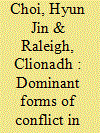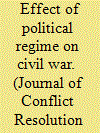|
|
|
Sort Order |
|
|
|
Items / Page
|
|
|
|
|
|
|
| Srl | Item |
| 1 |
ID:
138307


|
|
|
|
|
| Summary/Abstract |
Our article analyzes how transitioning political institutions create incentives and disincentives for opposition groups to incite different forms of political violence. We argue that variation on two specific parameters of governance—checks and balances and political participation—compels states toward one of the three forms of conflict, including civil wars, political militia, and riots. Using disaggregated data on different types of political violence across Africa from 1997 to 2012, we analyzed two parameters of governance in both count and change models. We also identified high-risk conflict periods. Typical regime types (democracy, autocracy, anocracy) cannot explain manifestations of conflict, as violence occurs in regimes with varying levels of political openness and competition. Opposition groups actively respond to regime transitions, as changes in institutional parameters correlate with shifts into alternative forms of violence within states.
|
|
|
|
|
|
|
|
|
|
|
|
|
|
|
|
| 2 |
ID:
082406


|
|
|
|
|
| Publication |
2008.
|
| Summary/Abstract |
Research published in the American Political Science Review shows that anocracies-as defined by the middle of the Polity index of political regime-are more susceptible to civil war than are either pure democracies or pure dictatorships. Yet, certain components of the Polity index include a factional category, where political competition is ``intense, hostile, and frequently violent. Extreme factionalism may be manifested in the establishment of rival governments and in civil war'' (Gurr 1989, 12). Not surprisingly, these components exhibit a strong relationship with civil war. When they are removed from the Polity index, however, the original relationship disappears. I conclude that the original finding is not driven by the relationship between political institutions and civil war but rather by a less provocative relationship between political violence and civil war.
|
|
|
|
|
|
|
|
|
|
|
|
|
|
|
|
| 3 |
ID:
190023


|
|
|
|
|
| Summary/Abstract |
Previously rare events, mass protest movements have become popular vehicles for those seeking political, economic, and social change. How do we evaluate movement success? Most studies addressing movement outcomes are grounded in the goal attainment approach, where movement success is dependent upon fulfilling one’s stated demands. The models derived from this approach heavily rely on visibility and transparency in the policymaking process. These offer limited analytical utility for scholars studying movements in authoritarian states, where policymaking is shrouded and media is state-controlled. Evaluating movements solely on their fulfillment of mission goals is highly problematic, as movements produce more outcomes than their intended goals. Movements also produce unintended benefits: concessions unrelated to the movement’s mission. These include negative consequences, or societal costs. Since movements produce both positive and negative unintended outcomes, any evaluation of a movement should also incorporate the costs associated with new gains. I argue a cost–benefit approach improves scholarly conceptualization and measurement of protest success. I conceptualize protest success as multidimensional and comprised of protest gains and societal costs. I develop a 21-point scale of protest success using Mokken Scale Analysis. AISP diagnostics indicate gains and costs comprise separate subscales, which are collapsed to produce total sum scores. I score 34 nonviolent movements in authoritarian states between 2002 and 2013 on an additive scale. Protests in authoritarian settings attain considerable accomplishments; however, those gains come with significant cost. Most total success scores are negative, indicating considerable backlash is common during and immediately after the demobilization of movements in authoritarian states. Success scores improve upon the canonical binary measure by: (1) offering improved discrimination between movements, (2) identifying cases of regime ‘ignoring’, and (3) pinpointing misclassified cases. By incorporating negative consequences into our evaluations, we advance our understanding why movements deemed successful by scholars are disappointments to their home publics.
|
|
|
|
|
|
|
|
|
|
|
|
|
|
|
|
|
|
|
|
|